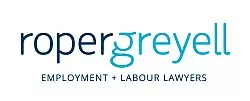It seems like every day a new story surfaces about allegations of sexual harassment against Hollywood elites and other celebrities. Each time, the online world erupts and anyone with a computer can have their say. Reputations can be destroyed in hours. One wonders what would have been done differently. What if there had been the equivalent of a Respectful Workplace Policy or Code of Conduct in Hollywood, setting out expectations on standards of behaviour and reporting mechanisms when transgressions occurred? Would this have been enough to prevent the seemingly widespread misconduct we've been hearing about, or is that wishful thinking, the stuff of Hollywood fairy tales?
While many of us here in the 'real world' may not be able to relate to the goings-on of Hollywood, the fact is that over the past several years there have been many examples of high‑profile companies that have been thrust into the media spotlight when an employee has engaged in sexual harassment or other inappropriate conduct. 'Employees behaving badly' is easy internet fodder and many companies have suffered significant reputational damage when workplace issues have been made public. Think of the CBC and Jian Gomeshi, or, more recently, the creative writing department at Concordia University.
What the last few years has made clear is that if employees do not feel that their employer is going to effectively handle their concerns around bullying and harassment, or if they feel that nothing is being done to protect them, there is a willingness to go public with concerns. As employment lawyers, we often see cases of employees airing their employers' dirty laundry on social media platforms. Once this happens, companies can find themselves very quickly in the midst of public relations disasters. We have also seen how effective well-drafted policies and procedures can be in preventing incidents in the first place and then managing the fallout when incidents do occur. As the saying goes, an ounce of prevention is worth a pound of cure.
Given the current media focus, now is a perfect opportunity to consider what your company is doing with respect to bullying and harassment in the workplace. We recommend that you take an inventory of all policies and procedures that relate to the working environment and consider the following questions:
- Are your policies and procedures sufficient to satisfy your legal obligations with respect to bullying and harassment in the workplace? and,
- Are your policies and procedures actually creating the working environment that you are striving for? Do they align with the company's core values and principles?
What are the legal requirements?
In determining whether your policies are legally sufficient, consider the legal obligations for employers under both the Workers Compensation Act (the "WCA") and the Human Rights Code (the "Code").
Pursuant to the WCA, bullying and harassment are considered to be workplace hazards. An employer has a duty to prevent workplace bullying and harassment as part of the duty to ensure the health and safety of its workers. Pursuant to WorksafeBC policy, an employer must:
- Develop a policy statement indicating that workplace bullying and harassment are not acceptable or tolerated;
- Develop and implement a procedure for reporting bullying and harassment including how, when and to whom reports/complaints should be made;
- Develop and implement procedures for how workplace bullying and harassment will be dealt with including: how and when investigations will be conducted, and what will be included in the investigation; and roles and responsibilities of employers, supervisors, workers and others; and
- Inform and train workers and supervisors with respect to the policy and procedures.
Often companies will incorporate all of these requirements in a Respectful Workplace or equivalent workplace policy. If you have such a policy, consider if it satisfies the above elements. If you do not have such a policy, you will need to implement one – now is certainly not the time to fall short in this area. While precedents and templates are useful as a starting point, you should ensure the policy and procedure you create are appropriate for your particular workplace.
As mentioned above, as well as WorksafeBC obligations, an employer also has a human rights obligation to protect its employees from harassment on the basis of prohibited grounds (e.g. sex, disability, race, gender, religion, etc.). It is possible to have one policy that covers both WCA and Code obligations, but keep in mind that the definition of harassment is different depending on the context. For example, it is possible for conduct to be considered harassment under the WCA but not under the Code. This is another reason why template policies generally are a good starting point but not a complete solution.
Ultimately, an employer's goal should be to prevent any incidents of bullying and harassment. This is a lofty goal and often incidents will occur despite best practices. When incidents do occur, if there is a clear policy statement and a well-defined procedure in place, there is a better chance that your employees will feel supported, the complaint will be managed effectively, corrective measures will be taken and unwanted publicity can be avoided. This is a win-win for everyone involved.
Lessons for Employers:
- Employers have a legal obligation to take all reasonable precautions to prevent bullying and harassment in the workplace. This includes having a policy statement and procedures in place to deal with incidents of bullying and harassment.
- Consider if your company's policies are compliant with legal obligations and effective in creating the sort of working environment that aligns with your company's values and principles.
- Template policies are a good starting point but will often fall short of best practice. Policies and procedures should be tailored to suit your company's specific needs. An employment lawyer with expertise in this area can help revise existing policies or create new ones.
- Having a clearly delineated complaint procedure can reassure your employees that bullying and harassment will be properly addressed if and when they arise.
- An essential component of an effective policy is regular and consistent training. Best practice is to hold a training/refresher session at least once per year, and have all employees sign off on having completed the training and that they agree to abide by the company's policy.
The content of this article is intended to provide a general guide to the subject matter. Specialist advice should be sought about your specific circumstances.


